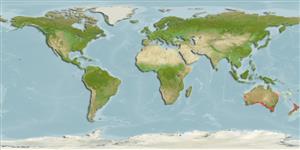Environment: milieu / climate zone / depth range / distribution range
البيئة
بحري; مياه مخلوطة; نطاق العمق 31 - 70 m (Ref. 58489). Subtropical; 20°S - 47°S, 109°E - 177°W (Ref. 189)
Southwest Pacific: Australia (from Queensland at about Cape Capricorn south to southern Tasmania; entire southern coast of Australia, except for Great Australian Bight, and north to Shark Bay, Western Australia), including Lord Howe Island and Norfolk Island; and New Zealand (most of the North Island and all but the southeast coast of the South Island).
Length at first maturity / الحجم / وزن / العمر
Maturity: Lm 6.5, range 6 - 7 cm
Max length : 15.0 cm SL ذكر/ مختلط الجنس; (Ref. 33832); common length : 12.0 cm SL ذكر/ مختلط الجنس; (Ref. 9822); العمر: 6 سنين (Ref. 6390)
الأشواك الظهرية (المجموع): 0; الأشعة الظهرية الناعمة (المجموع): 13-18; شوكة شرجية 0; أشعه شرجية لينه: 17 - 19; فقرات: 40 - 48. Hardly differs from the European anchovy (E. encrasicolus) and can be identified from that description. For most of its range it is the only anchovy present, but in the extreme north it may overlap with species of Encrasicholina or Stolephorus, which have small needle-like scutes before the pelvic fins; species of Thryssa have compressed bodies and a keel of scutes along the belly.
Found mostly inshore: chiefly in bays, inlets and estuaries, sometimes in low salinities. Older individuals tend to move out to sea in winter and back in the spring. Forms compact schools much preyed upon by larger fishes, common dolphins and birds. Feeds on plankton. Spawns in inlets, bays and also estuaries, probably throughout the year but mainly in late spring to early autumn and especially about November to February. The eggs are ellipsoidal. Utilized as fish paste.
Spawns in inlets, bays and estuaries.
Whitehead, P.J.P., G.J. Nelson and T. Wongratana, 1988. FAO Species Catalogue. Vol. 7. Clupeoid fishes of the world (Suborder Clupeoidei). An annotated and illustrated catalogue of the herrings, sardines, pilchards, sprats, shads, anchovies and wolf-herrings. FAO Fish. Synop. 125(7/2):305-579. Rome: FAO. (Ref. 189)
IUCN Red List Status (Ref. 130435)
استخدامات بشرية
مصائد: غير مهمة تجارياً; طعم: usually
مزيد من المعلومات
مراجعالأستزراع المائيملف الأستزراع المائيسلالاتجينيElectrophoresesالتوريثالأمراضمعالجةNutrientsMass conversion
المتعاونينصورStamps, Coins Misc.اصواتالتسمم باكل السمكسرعةنوع السباحةمنطقة الخياشيمعظمة الأذندماغرؤية
أدوات
تقارير خاصة
Download XML
مصادر علي الأنترنت
Estimates based on models
Preferred temperature (Ref.
123201): 14.3 - 24, mean 17.1 °C (based on 72 cells).
Phylogenetic diversity index (Ref.
82804): PD
50 = 0.5020 [Uniqueness, from 0.5 = low to 2.0 = high].
Bayesian length-weight: a=0.00457 (0.00213 - 0.00980), b=3.12 (2.95 - 3.29), in cm total length, based on LWR estimates for this Genus-body shape (Ref.
93245).
مستوى غذائي (Ref.
69278): 3.0 ±0.00 se; based on food items.
Generation time: 2.8 ( na - na) years. Estimated as median ln(3)/K based on 2
growth studies.
المرونه (Ref.
120179): عالي, الحد الزمني الأدني لتضاعف عدد أفراد المجتمع أقل من 15 شهر (K=0.39; tm=1; tmax=6).
Fishing Vulnerability (Ref.
59153): Low to moderate vulnerability (25 of 100).
Nutrients (Ref.
124155): Calcium = 213 [100, 489] mg/100g; Iron = 1.3 [0.6, 3.0] mg/100g; Protein = 18.7 [17.5, 19.9] %; Omega3 = 0.838 [0.500, 1.399] g/100g; Selenium = 12.4 [5.6, 24.6] μg/100g; VitaminA = 19.9 [5.6, 69.1] μg/100g; Zinc = 1.47 [0.94, 2.25] mg/100g (wet weight);
